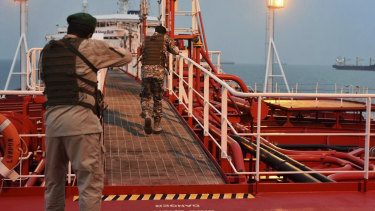ASX to open soft as US-Iran tensions grow, oil price rises
Australia’s sharemarket is set for a “softish” open as concern grows over escalating US-Iranian tensions and the potential it may push the oil price higher.
Global markets reacted negatively to the US drone strike that killed Iranian military chief Qassem Soleimani on Friday.
It also eroded ASX gains as the week closed pushing the futures market down four points or 0.1 per cent.

Tensions have flared again after the assassination of Qassem Soleimani by the US.Credit:Mehr News Agency
“That’s suggesting that unless there is a further deterioration in the situation between Iran and the US that we’ll open flat to maybe just down slightly,” AMP Capital’s chief economist Shane Oliver said.
“So it looks like a softish start … possibly down about five points.”
The oil price rose about 3 per cent or $US2 per barrel to $US63.05 following the US attack in Iraq and could go higher.
“There’s nervousness about what sort of retaliation, if any, Iran will undertake against the US for killing one of its generals and what that’ll mean for oil price,” Dr Oliver said.
“So far it hasn’t been that big a rise … it’s really only worth about 2 cents per litre at the bowser but for Australian motorists, it’s come at a bad time.”
Mixed with growing community concern over the ongoing bushfire crisis, it could further weigh on consumer spending.
He added that bushfires would add to the pressure for more rate cuts from the Reserve Bank of Australia and federal fiscal stimulus.
“It’s not that great for the economy,” Dr Oliver said.
In the week ahead, all eyes will be on US payroll figures, which are expected to show continued strength in the job market, subdued wages growth and a low unemployment rate.
In China, inflation results are likely to show a small rise in the inflation rate to reflect increasing food prices.
Locally, November’s building approvals figures set for release on Wednesday are expected to show a rise following October’s 8 per cent fall.
“We might get a bit of a bounce-back but they’ll still remain pretty weak,” Dr Oliver said.
Australian Bureau of Statistics’ November job vacancy data, also due on Wednesday, is expected to show a further fall in vacancies.
On Thursday the trade balance figures are expected to show a further decline in Australia’s surplus in response to the downtrend in iron ore prices.
The “big thing to watch”, however, are Friday’s November retail sales figures, which Dr Oliver said could be up as much as 6 per cent.
“October was flat but there’s a good chance November might see a bit of a spike because of the Black Friday and Cyber Monday sales,” he said.
Dr Oliver said the sales might have encouraged Australians to spend money they had saved as a result of the federal government’s tax cuts and lower mortgage interest rates.
“The only thing is, it may have just brought forward spending that usually occurs in December,” he said.
“So a bit of a spike in retail sales but then possible payback a month later.”
AAP
Most Viewed in Business
Source: Thanks smh.com